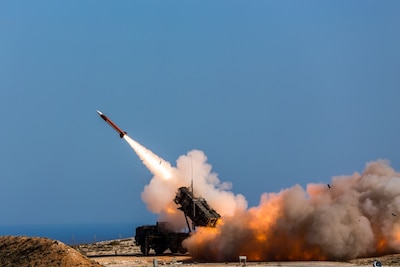By Army Capt. Robert Durr, 10th Army Air and Missile Defense
Command
CHANIA, Greece, Nov. 13, 2017 — More than 200 U.S. soldiers
from the 10th Army Air and Missile Defense Command participated in Artemis
Strike 2017, a German-led multinational tactical live-fire exercise held Nov.
2-9 at the NATO Missile Firing Installation here.
Soldiers from 5th Battalion, 7th Air Defense Artillery
Regiment worked with more than 650 German airmen from the Surface Air and
Missile Defense Wing 1 to create an integrated air and missile defense system
construct as part of a NATO tactical evaluation.
Army Col. David Shank, commander of the 10th AAMDC, said
this year’s exercise gave soldiers a chance to work with partners and allies in
an environment that replicates real world conditions.
Constant Training
“This is a great opportunity for soldiers to do what they
came in the Army to do, and that’s to put steel on targets,” Shank said. “We
consistently train not only with our German allies but across the continent of
Europe.”
For soldiers in 10th AAMDC, Artemis Strike 2017 has been a
year in the making.
“The planning for this event began well over a year ago,
during the last live-fire exercise here in Crete,” Shank said. “There is quite
a bit of planning and execution.”
The 5-7 ADA out of Smith Barracks in Baumholder, Germany,
deployed with two Patriot battery minimum engagement packages, along with
soldiers from Headquarters and Headquarters Battery to support their German
allies during the multinational event.
“It’s about integration and it’s about having an integrated
air and missile defense capability,” Shank said. “This is what soldiers train
for and this is how we improve our craft. Our No. 1 priority is to get better
every day. We’ll continue to support our allies and our partners.”
Mission Success
For the soldiers participating in the exercise, rehearsals
and training have played a key role in the success of the mission.
Army Spc. Nathaniel Murray, a Patriot launcher crewmember
with Bravo Battery, 5-7 ADA, said one of the most significant things about the
exercise is being able to operate with NATO partners and allies.
“They have the same weapon platform that we do, but theirs
varies a little bit,” Murray said. “One of the best things about being out here
is actually being able to see the missiles fire off. We train everyday with
simulations, but it’s great actually being able to finish the crew drill,
unlock and connect the missiles and see the product of all of our hard
training.”
Army Sgt. Zach Nacarato, an assistant section chief with
Bravo Battery, 5-7 ADA, said working with U.S. allies and partners has been
mutually beneficial to both the U.S. and German forces participating in this
year’s exercise.
German soldiers assigned to Surface Air and Missile Defense
Wing 1 fire the Patriot air defense missiles at the NATO Missile Firing
Installation during Exercise Artemis Strike 2017 in Chania, Greece.
German soldiers assigned to Surface Air and Missile Defense
Wing 1 fire the Patriot air defense missiles at the NATO Missile Firing
Installation during Exercise Artemis Strike 2017 in Chania, Greece, Nov. 8,
2017. Artemis Strike is a German-led multinational air defense exercise. German
air force photo by Officer Candidate Sebastian Apel
“It’s a really great opportunity for soldiers to do this,”
Nacarato said. “It’s the best training I think anyone could ever receive --
especially working with our brothers in Patriot.”
German air force Col. Arnt Kuebart, commander of the Surface
Air and Missile Defense Wing 1, said working with U.S. forces is an essential
part in Artemis Strike’s success.
“Integration in terms of air defense and air missile defense
is absolutely key. No single nation is capable and able to perform air missile
defense alone,” Kuebart said. “This is a truly joined and combined endeavor
where different services and different nations have to come together and
intertwine their services and their capabilities.”
Exercises like Artemis Strike improve integration training
between NATO allies and partners, Kuebart said.
“The very big benefit of this exercise is that you are
working in a tactical scenario therefore also proving your capability through a
live firing with missiles,” he said.
Soldiers from 3rd Battalion, 4th Air Defense Artillery
Regiment, 32nd AAMDC, 21st Theater Sustainment Command, 7th Army Training
Command, 173rd Airborne Brigade, 2nd Cavalry Regiment, 16th Sustainment Brigade
and the 30th Medical Brigade also participated in the exercise alongside their
German counterparts.







No comments:
Post a Comment